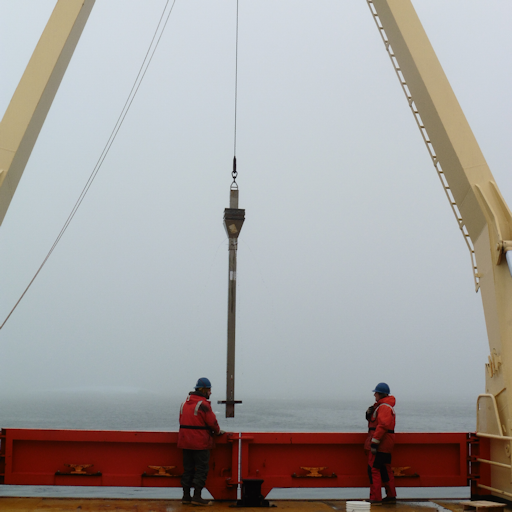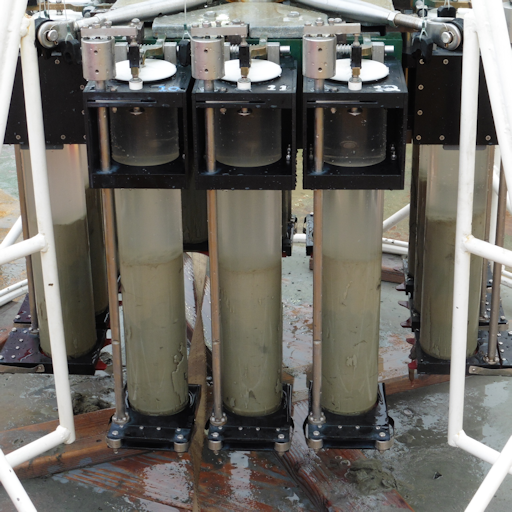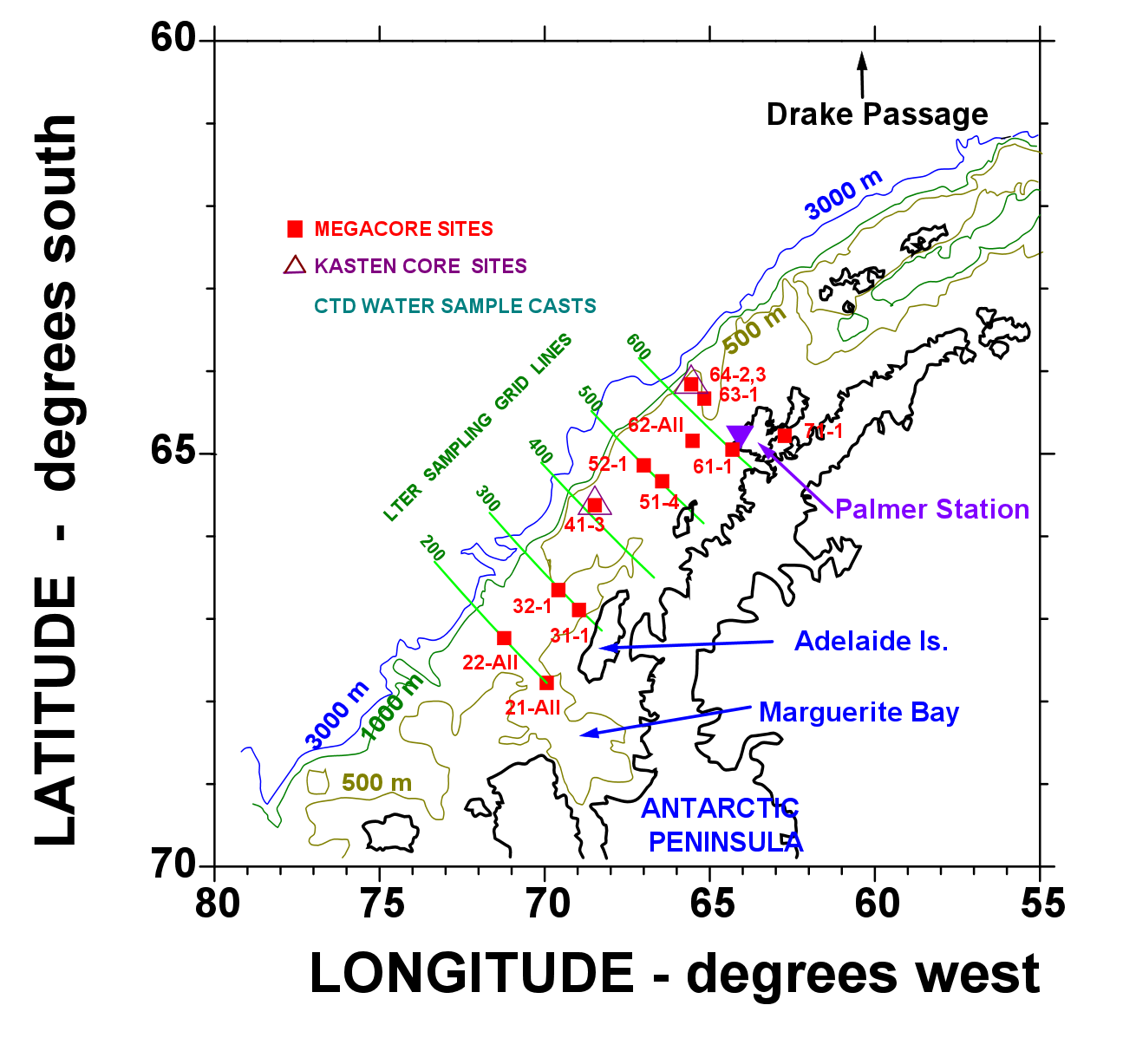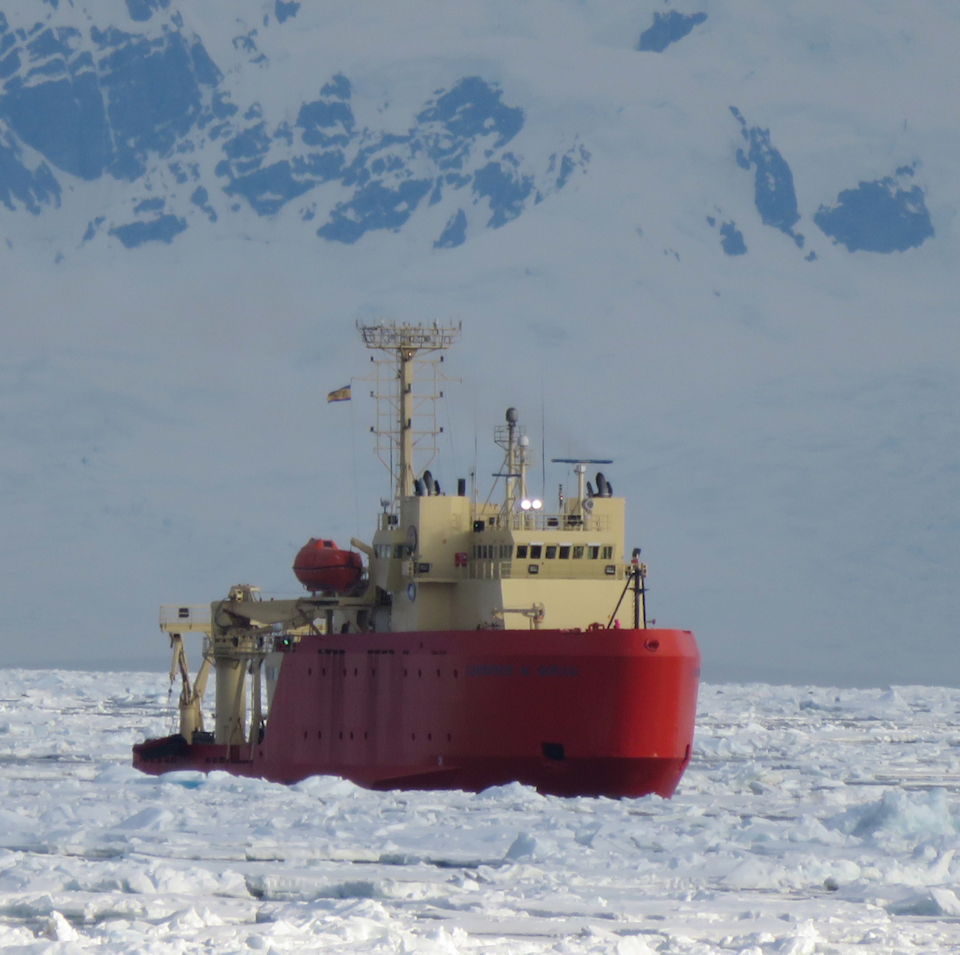Antarctic Iron Project
The project, “organic carbon oxidation and iron remobilization by West Antarctic shelf sediments” by J.P. Christensen and D.J. Burdige, was funded by the Antarctic section of the U.S. National Science Foundation. The goal of this project was to determine the amount of iron in the continental shelf sediments off Antarctica and to evaluate the possible release of this iron into the sea water.
This page presents a short description of the project and is offering free downloading by viewers of data collected on this project.
DOWNLOAD THE DATA
The resulting analytical data are presented in the zip file, WA16DATA.zip, which contains 7 files. To download this zip file, click on the download button.

Scientists on the R.V. Palmer prepare to collect a 12 foot long gravity core of the sediments off Antarctica. (photo by D. Burdige)
PURPOSE OF THE STUDY
Since the mid 1990’s, the Palmer Long-Term Ecological Research Project had been studying plant productivity in the continental shelf waters off the Antarctic Peninsula. The prediction was that upcoming climate change would dramatically reduce the sea-ice cover in the region. This would allow the increased penetration of sunlight into the underlying waters, and would drive increased plant production. As a result, the ecosystem would flourish and the region would be come ecological richer and more diverse. After several decades of monitoring, these changes did not appear. The sea-ice cover was dramatically reduced but ocean productivity remained variable but generally unchanged.

Several freshly-collected sediment cores from the deep continental shelf off Antarctica. (photo by D. Burdige)
It was realized that productivity in this region was not driven by the combination of sunlight and common nutrients such as nitrate nitrogen. Instead, productivity was limited by the lack of the micro-nutrient, iron. In much of the surface ocean, iron is supplied by rivers, by mixing with deeper nutrient rich waters, and by atmospheric deposition of desert dust, generally in quantities greater than needed by the planktonic plants. In these regions, growth typically is limited by the available nitrogen. But off frozen Antarctica, rivers are essentially non-existent and the region’s ocean is too far south to receive dust blowing off of the southern deserts of Africa, South America, and Australia. Since the Antarctic continent is covered both by glaciers and permanent snow fields, essentially no dust is produced from the near-by land. Consequently, the oceans around Antarctica are iron-limited. The dramatic warming around the Antarctic Peninsula has caused greatly reduced sea-ice cover, but the plants remain limited by the lack of the available iron.
In most mid-latitude continental shelves, the sediments contain a great deal of iron, primarily within the sediment grains and as deposits and coatings on the exterior of the grains. Within these sediments, a part of the stored iron reacts with seawater in a variety of ways, becomes soluble, and randomly diffuses out of the sediments into the water column. Presumably, Antarctic shelf sediments are similar and so these sediments could be an important source of iron to the seawater and perhaps to the plants near the sea surface. The goal of the study was to evaluate how much iron was in the shelf sediments off the Antarctic Peninsula, and to estimate whether the sediments could be a naturally occurring source of iron for the local seawaters.

Locations of sediment coring sites and of water column sampling sites on the West Antarctic continental shelf.

The research vessel L.M. Gould in sea-ice along the Antarctic coastline. (photo by D. Burdige.)
We traveled to southern Chili where we met the U.S. research vessel, R. V. Nathaniel B. Palmer. After crossing the Drake Passage between South America and Antarctica, sampling was begun at 12 locations on the Antarctic Shelf. At all sites, sediment coring was done using a multiple corer, which collects up to 12 replicate sub-cores each of about 30 cm in depth. At two of the sites, 1-2 m long cores were also collected using a Kasten core, which is a free-falling gravity-driven sediment corer. At all sites, water samples from above the sediments were collected using a CTD-Rosette system. The CTD portion of this instrument continuously measures the salinity, temperature, and depth of the instrument during its deployment. From these, we get vertical distributions of the waters from the sea surface down to just above the sediments. The Rosette portion of the system has 24 sampling bottles, each of which collects 30 liters of seawater at the selected depth in the profile. These seawaters are used for various measurements in conjunction with the sediment measurements. The sediment cores were subdivided into horizontal strata, sediment slices made parallel to the sediment surface, the strata being 0.5 cm thick near the sediment surface and as much as 3.0 cm thick at depth. Each strata was further subdivided into separate subsamples of the whole sediment. Each subsample was used for different analyses. One set of whole-sediment subsamples was processed to separate the seawater contained between the sediment grains (called the porewater). These porewaters were then used for a variety of analyses. In some replicate sub-cores, very small oxygen electrodes were inserted into the top of the core and slowly pushed downward deeper into the sediments. These micro-electrodes measured the dissolved oxygen content of the porewaters at all the sampled depths.
Conclusions
As a result of this work, the authors determined that the Antarctic continental shelf sediments contain significant quantity of iron. The average amount within the sampled stations was about 10,000 gm Fe/ 0.3 cubic meter of sediment. This volume of sediment is 30 cm deep (the height of the subcores) for a square meter of sediment surface. The seawater concentration averages 2-3 nanomoles Fe/L over an average water column depth of 610 m. So a column of sea water on the Antarctic continental shelf with a sea-surface area of 1meter x 1meter contains 0.07-.10 gm Fe. In comparison, the upper 30 cm of sediment contains about 100,000 times more iron than the overlying water column. Most of the sediment iron is fixed within the sediment grains, and the portion of the total iron which can be mobilized is a small fraction of the total. Very little of the soluble iron is near the sediment-water interface so almost none diffuses back into the water column.
These results are also presented in scientific journals (see the scientific paper, Antarctic Iron listed in the Polar Oceans Literature section) and at scientific conferences.
